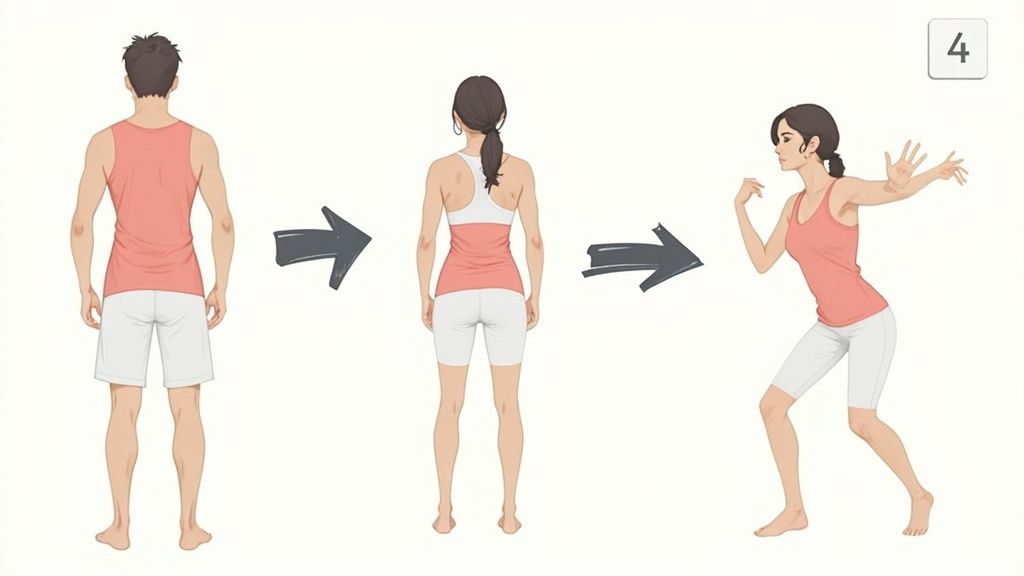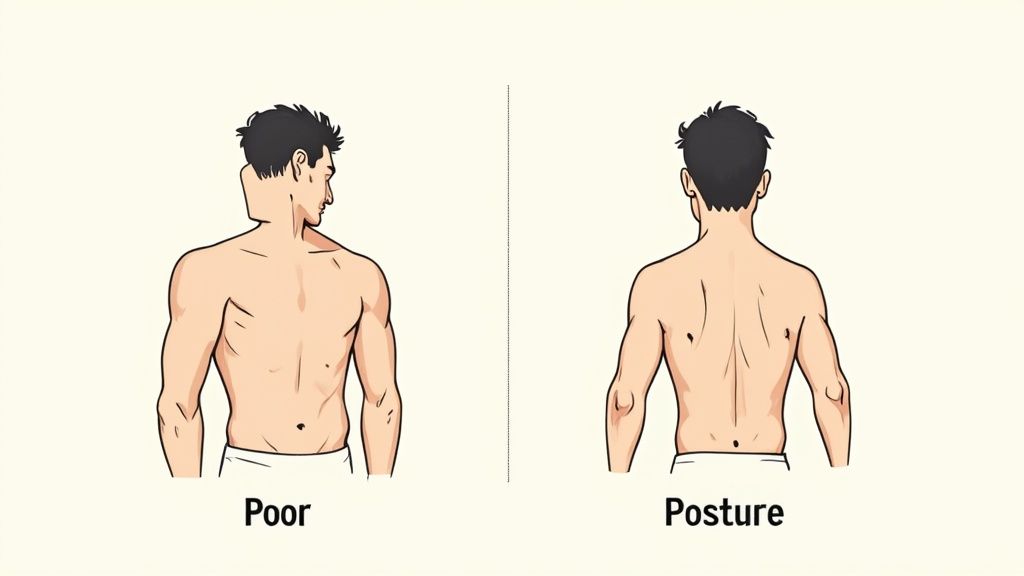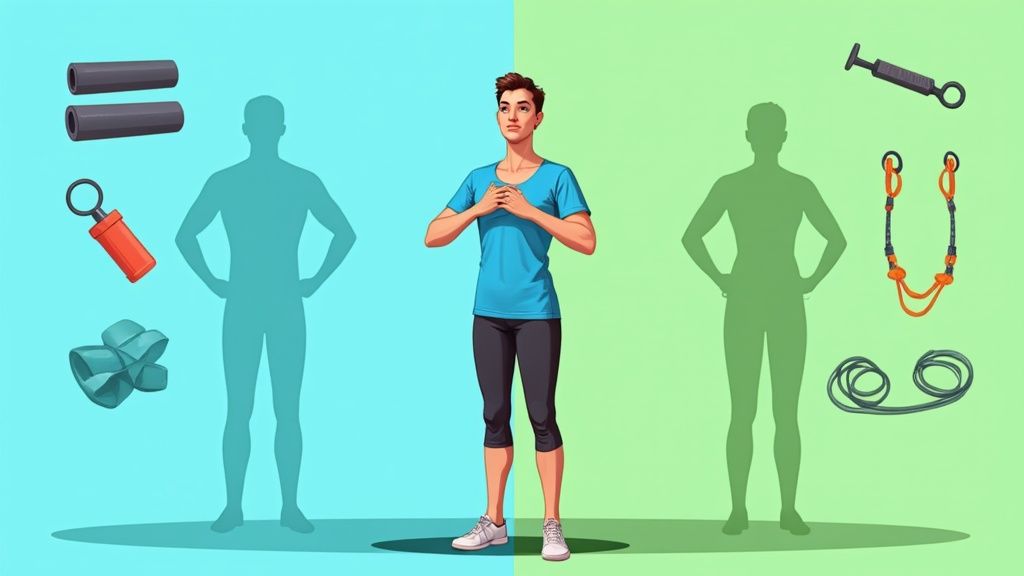How to Fix Rounded Shoulders: A Science-Backed Guide to Better Posture
Understanding Your Rounded Shoulders Journey

Poor posture in the form of rounded shoulders affects many people today. While it may seem like just a visual concern, rounded shoulders can actually lead to significant physical limitations and ongoing discomfort. To effectively address this issue, it's essential to first understand what causes rounded shoulders and how they develop over time.
The Anatomy of Rounded Shoulders: Muscle Imbalances at Play
The root cause of rounded shoulders lies in an imbalance between chest and back muscles. When chest muscles (pectorals) become overly tight and shortened while upper back muscles (rhomboids and trapezius) grow weak and stretched, the shoulders naturally pull forward. Think of it as a simple tug-of-war - the tight chest muscles win, pulling your shoulders out of their proper alignment. Over time, this creates ongoing strain that can cause persistent pain in your upper back, neck and shoulder areas.
Modern Life and the Rise of Rounded Shoulders: How Our Habits Contribute
Our daily routines often make rounded shoulders worse without us realizing it. Long hours at desks, looking down at phones, and driving create positions that reinforce poor posture. For instance, when you constantly tilt your head down to check your phone, it strains your neck and upper back muscles. Even seemingly minor habits like carrying heavy bags incorrectly can gradually worsen rounded shoulders. By understanding how these everyday activities affect our posture, we can start making better choices.
Beyond Aesthetics: The Real Impact of Rounded Shoulders
Rounded shoulders cause more problems than just poor posture. This condition can limit how well you move your shoulders, making simple tasks like reaching overhead much harder than they should be. It can even affect your breathing by compressing your chest cavity and reducing lung capacity, which in turn impacts your energy levels. Research shows that people with rounded shoulders often experience more pain between their shoulder blades. Fixing rounded shoulders isn't just about looking better - it's about feeling better and moving more freely in your daily life.
Breaking the Cycle: Why Traditional Approaches Often Fall Short
Many people try to fix rounded shoulders by only doing back-strengthening exercises. However, this approach misses a crucial part of the solution. It's like trying to straighten a bent wire without first loosening what's holding it in the wrong position. Your tight chest muscles will keep pulling your shoulders forward unless you address both problems together. For lasting improvement, you need to both stretch tight muscles and strengthen weak ones. This balanced approach offers the best path to better posture.
Building Your Shoulder Correction Toolkit

To effectively fix rounded shoulders, you need both stretching and strengthening exercises working together. Simply doing back exercises won't address tight chest muscles that pull your shoulders forward. That's why it's essential to build a complete set of targeted movements that tackle all aspects of the problem. Understanding how each exercise helps correct muscle imbalances will help you stay motivated and consistent.
Essential Stretches for Opening Tight Chest Muscles
When your chest muscles are tight, they constantly pull your shoulders into a rounded position. Regular chest stretches help counter this by lengthening the pectoralis major and minor muscles to improve shoulder alignment. Here are some proven stretches you can try:
Doorway Stretch: Start by standing in a doorway with your arms bent at 90 degrees and forearms resting on the frame. Gently lean forward until you feel a stretch across your chest. Hold for 30 seconds and repeat several times. You can easily adjust this stretch based on different doorway widths.
Corner Stretch: Find a corner and place your forearms on each wall, then lean your body weight forward to feel the chest stretch. The angle of the corner allows for an especially effective stretch.
Supine Chest Stretch with a Foam Roller: Lie on your back with a foam roller placed vertically along your spine. Let your arms rest out to the sides with palms facing up. This position uses gravity to naturally open up the chest and increase flexibility.
Key Strengthening Exercises for Supporting Proper Shoulder Alignment
While stretching helps loosen tight muscles, you also need to strengthen the opposing muscle groups to pull your shoulders back into proper position. Focus on exercises that target your upper back muscles - especially the rhomboids, trapezius, and posterior deltoids. This builds stability in your shoulder girdle for better posture.
Scapular Retractions: In a seated or standing position, let your arms relax by your sides. Squeeze your shoulder blades together as if trying to hold something between them. Hold briefly, then release. This simple movement strengthens key posture muscles like the rhomboids and middle trapezius.
Band Pull-Aparts: Hold a resistance band with arms extended in front of you. Pull the band apart while focusing on squeezing your shoulder blades together. This targets rear deltoids and upper back muscles needed for proper shoulder movement.
Reverse Flyes: Lying face down on a bench or floor, hold light dumbbells with arms hanging down. Lift your arms out to the sides while squeezing shoulder blades together. This builds strength in posterior deltoids and rhomboids to support better posture.
Building a Balanced Routine for Lasting Results
Research shows that combining stretching and strengthening exercises leads to better results than doing just one type. For example, a study in Physical Therapy in Motion found significant posture improvements when participants did both kinds of exercises regularly. Try to do these exercises several times per week, starting gradually and listening to your body's signals. Having this balanced approach of targeted stretches and strengthening moves will help you achieve lasting improvements in your posture, reduce pain, and move more freely.
Mastering Your Daily Posture Routine

Knowing how to integrate posture exercises into your daily routine is just as important as doing them correctly. Without a sustainable plan, even the most effective exercises won't deliver lasting results. Let's explore practical ways to build posture-improving habits that work with your lifestyle and schedule.
Structuring Your Day for Posture Success
Good posture habits need a strong foundation - just like any other health goal. Start by setting aside dedicated time blocks for your exercises, similar to how you'd schedule important meetings. For most people, 10-15 minutes in the morning and evening works well. The key is choosing times when you'll consistently be able to focus on proper form and technique.
Integrating Posture Exercises Into Your Schedule
Rather than overhauling your entire routine, look for natural opportunities to add posture work throughout your day. If you work remotely, take short exercise breaks between tasks. Office workers can do quick stretches during lunch or check their posture while seated. Set phone reminders to do scapular retractions or doorway stretches a few times daily. These small but frequent adjustments make a real difference in shoulder alignment.
Maintaining Proper Form Throughout the Day
Paying attention to your posture outside of exercise time is crucial for lasting improvement. One helpful mental cue is imagining a string gently pulling upward from the crown of your head - this reminder works whether you're sitting, standing, or walking. At your desk, position your monitor at eye level and ensure your chair provides good back support. Simple workspace tweaks like these reinforce proper alignment all day long.
Setting Up Reminders and Tracking Progress
Like any health goal, tracking helps maintain motivation and accountability. Use your phone, computer alerts, or simple sticky notes as posture reminders. Take progress photos from the front and side to document changes over time. Keep a basic journal noting how long you maintain good posture, any discomfort, and improvements you notice. Moova offers helpful 3-minute activity breaks to support better posture habits. Track specific metrics like stretch duration or exercise reps to steadily build strength and flexibility. This measured approach leads to real, sustainable changes in shoulder position and overall posture.
Unlocking Better Mobility Through Smart Stretching

A balanced mix of strengthening exercises and targeted stretches is essential for fixing rounded shoulders. But basic stretching alone often falls short. The real key lies in using specific techniques like Proprioceptive Neuromuscular Facilitation (PNF) and dynamic mobility work. These methods work better than simple static stretches to boost flexibility, increase range of motion, and support overall shoulder health. When you focus on these proven approaches, you'll see much better results in improving your shoulder alignment.
Exploring Advanced Stretching Techniques
PNF stretching uses controlled muscle contractions and relaxation to increase flexibility. For example, when stretching your chest muscles, you might work with a partner who provides resistance as you push against their hand, then relax as they help deepen the stretch. This contract-relax pattern helps your muscles extend further than they would with regular stretching. Dynamic mobility exercises, like arm circles, shoulder rolls, and torso rotations, get blood flowing and prepare your muscles for movement. These exercises work particularly well as a warm-up and help improve how you move in daily life.
Utilizing Tools for Enhanced Mobility
Simple equipment can make your stretching routine much more effective for fixing rounded shoulders. A foam roller helps release tension in chest and upper back muscles by rolling slowly over tight areas to break up muscle knots. Resistance bands add another dimension to stretches - try using them for doorway stretches or cross-body shoulder movements to create deeper, more productive stretches. These basic tools give you many options to improve flexibility and movement range.
Optimizing Timing and Sequencing
When and how you stretch makes a big difference. Do dynamic stretches before working out to warm up your muscles. Save static and PNF stretches for after exercise when your muscles are warm and more flexible. The order matters too - start with chest stretches to release tightness, then move to upper back stretches for better posture and mobility. This planned approach helps you get the most from each stretch and promotes proper shoulder positioning. Opening up tight chest muscles first makes it easier to strengthen your upper back afterward. Pay attention to how your body responds and avoid pushing too hard, especially at first. Making steady progress over time works better than forcing quick changes. Keep track of improvements like easier movement and less discomfort to stay motivated and avoid common mistakes.
Creating Your Posture-Friendly Environment
Good posture requires more than just exercises - it needs the right environment to thrive. Just like a garden needs good soil and optimal growing conditions, your body needs a supportive setting to maintain proper alignment. Here's how to create spaces that help fix rounded shoulders and support better posture.
Setting Up an Ergonomic Workspace
The many hours we spend at our desks can either help or hurt our shoulder alignment. Poor desk setup often leads to hunched posture and muscle imbalances, but some key adjustments can make a big difference in supporting good form.
Position your monitor at eye level to keep your head balanced on your spine rather than jutting forward. Keep your keyboard and mouse close enough that your elbows stay at 90 degrees without reaching. Choose a chair that supports your lower back's natural curve - either an ergonomic model or add a small lumbar pillow. Small tweaks like these reduce daily strain on your shoulders and back.
Choosing the Right Sleep Support
Your sleeping setup significantly impacts your posture, since poor support can reinforce rounded shoulders for hours each night. Start with a supportive mattress that keeps your spine aligned. Choose pillows based on your sleep position - side sleepers often need thicker ones while back sleepers do better with thinner options. Memory foam pillows work well for many since they conform to support your neck's natural curve.
Try to avoid stomach sleeping since it often twists your neck and shoulders. Back or side sleeping positions generally provide better alignment. Taking time to optimize your sleep setup is just as important as daytime posture habits for fixing rounded shoulders.
Modifying Everyday Activities
Simple daily tasks can either help or hurt your posture goals. When carrying groceries, distribute weight evenly between both sides. Hold your phone at eye level instead of looking down at it. Adjust your car seat to support proper spine alignment and take movement breaks on longer drives.
These small but consistent changes add up to better shoulder positioning throughout your day. Combined with targeted exercises and stretches, they create lasting posture improvements. Even minor adjustments make a difference when done regularly.
Tools like the Moova app can help by providing quick 3-minute exercise routines focused on mobility and posture. Having structured reminders and guidance makes it easier to maintain good habits. Focus on progress over perfection - steady small steps lead to meaningful changes in how you carry yourself.
Measuring Success and Maintaining Progress
Successfully fixing rounded shoulders requires paying attention to your progress and tracking changes over time. Just like maintaining any good habit, having clear ways to measure improvements helps you stay motivated and make adjustments when needed. This process of consistent evaluation ensures you stay on course while giving you valuable insights into what's working best for your body.
Visual Progress: Photos and Posture Checks
One simple but powerful way to track progress is through regular photos. Every few weeks, take front and side view photos against a plain wall to document changes in your posture alignment. While daily improvements may be subtle, comparing photos over time reveals gradual shifts that can be hard to notice otherwise. Throughout your day, check in with your posture - are your shoulders naturally sitting further back? Do you catch yourself slouching less often? These day-to-day observations provide helpful feedback on your progress.
Functional Improvements: Range of Motion and Reduced Pain
Beyond visual changes, pay close attention to how your body feels during daily activities. Can you reach overhead more easily? Has that persistent ache between your shoulder blades started to fade? These functional improvements often bring the most satisfaction since they directly impact your quality of life. For instance, if grabbing items from high shelves used to cause discomfort but now feels smoother, that's a clear sign your efforts are paying off. After all, while better posture looks good, being able to move comfortably through your day matters most.
Refining Your Approach: When and How to Adjust
As your posture improves, you'll likely need to update your exercise routine. Basic movements that challenged you at first may become too easy over time. If you started with simple scapular retractions, you might progress to exercises like band pull-aparts or reverse flyes to keep strengthening those back muscles. This gradual increase in difficulty helps ensure continued improvement. However, if you experience ongoing pain or discomfort, check with a physical therapist who can assess your needs and suggest helpful modifications.
Realistic Expectations and Long-Term Maintenance
Improving rounded shoulders takes patience and dedication - there are no overnight fixes. Most people notice meaningful changes within a few months of consistent practice, though individual results vary. Be kind to yourself and celebrate small wins along the way. Remember that maintaining good posture requires ongoing attention. Once you achieve better shoulder alignment, include regular maintenance exercises in your weekly routine to protect your progress. Like brushing your teeth prevents cavities, consistent posture work helps preserve the improvements you've earned.
Looking for a simple way to incorporate posture-improving exercises into your busy schedule? Moova offers personalized 3-minute activity breaks designed to improve posture, boost energy, and alleviate stiffness. Download Moova today and start building a healthier, more active lifestyle: https://getmoova.app







